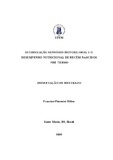| dc.creator | Höher, Francine Pimentel | |
| dc.date.accessioned | 2007-12-14 | |
| dc.date.available | 2007-12-14 | |
| dc.date.issued | 2005-03-17 | |
| dc.identifier.citation | HÖHER, Francine Pimentel. Oral motor-sensorial stimulation and the nutritional development in pre-term infants. 2005. 80 f. Dissertação (Mestrado em Fonoaudiologia) - Universidade Federal de Santa Maria, Santa Maria, 2005. | por |
| dc.identifier.uri | http://repositorio.ufsm.br/handle/1/6420 | |
| dc.description.abstract | The literature points to several studies in which the oral motor-sensory stimulation brings benefits to stimulated newborn child, like: more quick transition of the drip to oral way, winning of weight more quick too, early hospitalar discharge, increase of the force of suction, bigger consumption and transference of milk in relation to the time. The aim of this study was to verify the effects of the oral motor-sensorial stimulation and the nutritional development in pre-term infants. To do this, it was included 21 pre-term infants in the transition moment from the feeding through drip to oral via by medical release, confiner at the Delivery ward Intensive Care Unit (UTI) at Santa Maria University Hospital (HUSM). Two groups were constituted, one of them was the Stimulated Group (GE), composed by 10 infants, and the other one was the Controlled Group (GC), composed by 11 infants. Both groups were assessed and after a period of fourteen days maximum they were re-valuated. The GE group received oral motor-sensorial stimulation twice a day during a period comprised between the valuation and re-valuation. The GC group did not receive stimulation during this period. The orofacial valuation included oral reflection tests, valuation of the nutritive suckling characteristics and nutritional development valuation. During the nutritive suckling valuation was considered the presence and absence of the suckling in the moment of the feeding either by nursing bottle or suckling strength. The nutritional development was valuated through the volume prescribed and swallowed, in the transference rate of feeding and in the competence to feeding by oral via. Further, the time of the use of the drip was analysed, the time of transition of the drip to oral via and the increment of the weight after the intervention period. The obtained results suggest an improvement in suckling strength and in the nutritional development comparing valuation and re-valuation between the GE and the GC groups; however, there was not difference statistically significant between the groups. The results also suggest that the stimulation did not influence the time of the use of the drip, the time of transition of the drip to oral via and the increment of the weight to the studied groups. | eng |
| dc.format | application/pdf | por |
| dc.language | por | por |
| dc.publisher | Universidade Federal de Santa Maria | por |
| dc.rights | Acesso Aberto | por |
| dc.subject | Recém-nascido | por |
| dc.subject | Prematuro | por |
| dc.subject | Comportamento de sucção | por |
| dc.subject | Nutrição infantil | por |
| dc.subject | Newborn | eng |
| dc.subject | Preterm | eng |
| dc.subject | Sucking behavior | eng |
| dc.subject | Infant nutrition | eng |
| dc.title | Estimulação sensório-motora oral e o desempenho nutricional de recém-nascidos pré-termo | por |
| dc.title.alternative | Oral motor-sensorial stimulation and the nutritional development in pre-term infants | eng |
| dc.type | Dissertação | por |
| dc.description.resumo | A literatura aponta vários estudos em que a estimulação sensório-motora oral traz benefícios aos recém-nascidos estimulados, como: transição mais rápida da sonda para via oral, ganho de peso mais rápido, alta hospitalar precoce, aumento da força de sucção, maior consumo e transferência de leite em relação ao tempo. O objetivo deste estudo foi verificar os efeitos da estimulação sensóriomotora-oral no desempenho nutricional de recém-nascidos pré-termo. Para isso, foram incluídos 21 recém-nascidos pré-termo no momento da transição da alimentação por sonda para via oral por liberação médica, internados na UTI Neonatal do Hospital Universitário de Santa Maria (HUSM). Foram constituídos dois grupos, sendo um o Grupo Estimulado (GE), com 10 recém-nascidos, e outro o Grupo Controle (GC), com 11 recém-nascidos. Ambos foram avaliados e, após um período de no máximo quatorze dias, reavaliados. O GE recebeu estimulação sensório-motora oral duas vezes por dia durante o período compreendido entre a avaliação e a reavaliação. O GC não recebeu estimulação durante esse período. A avaliação fonoaudiológica incluiu a testagem dos reflexos orais, avaliação das características da sucção nutritiva e avaliação do desempenho nutricional. Na avaliação da sucção nutritiva, foi considerada a presença ou ausência da sucção no ato de amamentação por mamadeira e a força de sucção. O desempenho nutricional foi avaliado através do volume prescrito e ingerido, da taxa de transferência da alimentação e da competência para a alimentação por via oral. Ainda, foi analisado o tempo de uso de sonda, o tempo de transição da sonda para via oral e o incremento de peso após o período de intervenção. Os resultados obtidos sugerem melhora na força de sucção e no desempenho nutricional comparando-se avaliação e reavaliação entre o GE e o GC; porém, não houve diferença estatisticamente significativa entre os grupos. Os resultados sugerem, ainda, que a estimulação não influenciou o tempo de uso de sonda, o tempo de transição da sonda para via oral, e o incremento de peso para os grupos estudados. | por |
| dc.contributor.advisor1 | Keske-Soares, Marcia | |
| dc.contributor.advisor1Lattes | http://lattes.cnpq.br/2993790524055307 | por |
| dc.contributor.referee1 | Neiva, Flávia Cristina Brisque | |
| dc.contributor.referee1Lattes | http://lattes.cnpq.br/3822030530346786 | por |
| dc.contributor.referee2 | Haeffner, Leris Salete Bonfanti | |
| dc.contributor.referee2Lattes | http://lattes.cnpq.br/4056008693346464 | por |
| dc.creator.Lattes | http://lattes.cnpq.br/5542771442999974 | por |
| dc.publisher.country | BR | por |
| dc.publisher.department | Fonoaudiologia | por |
| dc.publisher.initials | UFSM | por |
| dc.publisher.program | Programa de Pós-Graduação em Distúrbios da Comunicação Humana | por |
| dc.subject.cnpq | CNPQ::CIENCIAS DA SAUDE::FONOAUDIOLOGIA | por |


